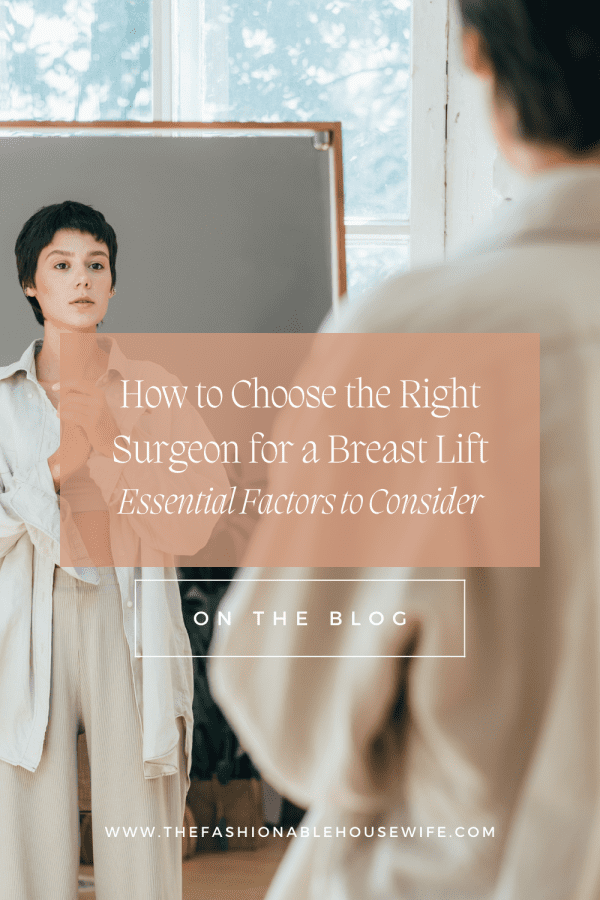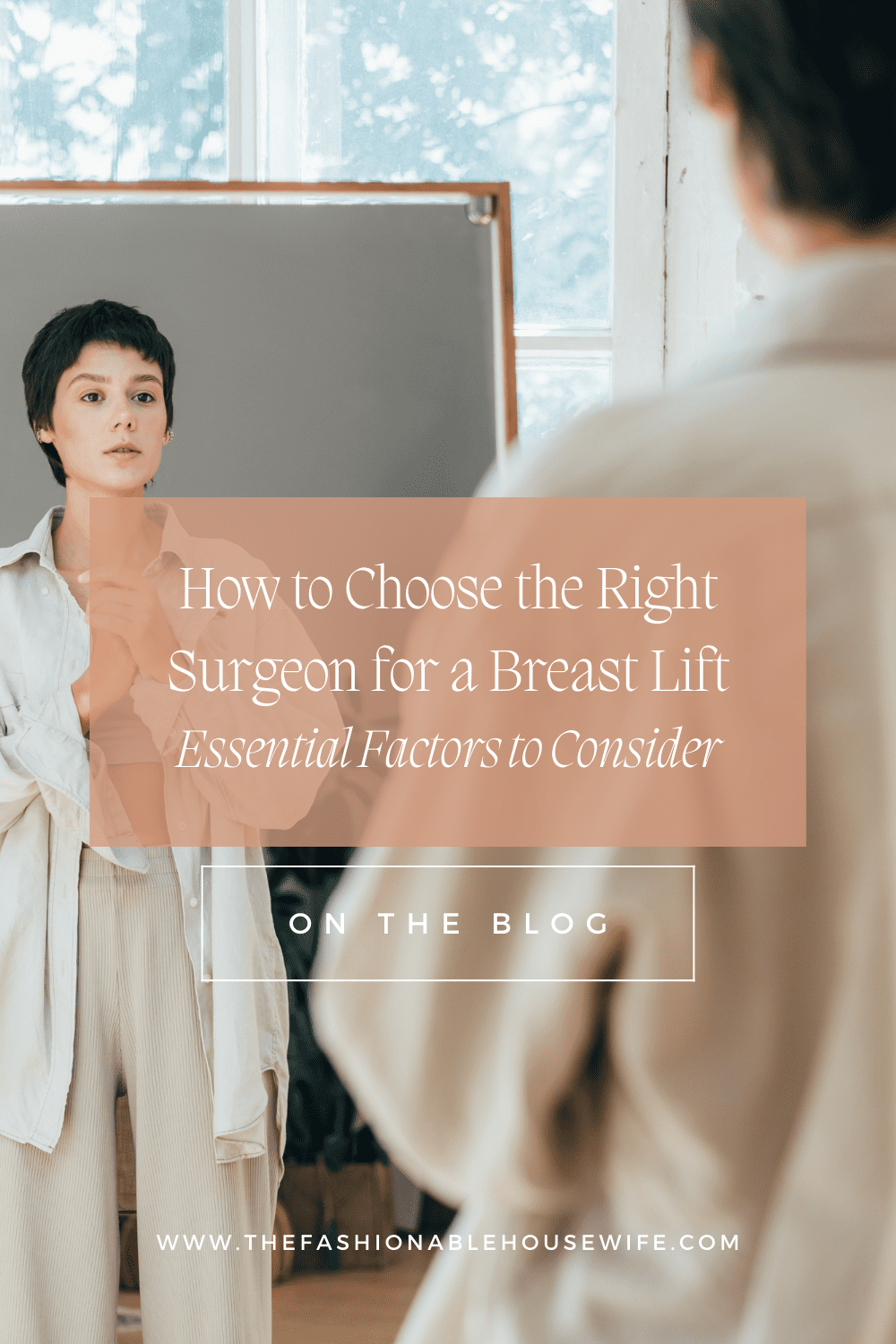How to Choose the Right Surgeon for a Breast Lift: Essential Factors to Consider

When contemplating a breast lift, finding a surgeon who is not only skilled but also one you trust is essential. A breast lift, or mastopexy, reshapes and raises the breasts by removing excess skin and tightening the surrounding tissue. This surgical procedure requires a trained professional to ensure that your aesthetic goals are met with the utmost safety and care. Bear in mind that your choice of surgeon greatly affects the outcome of your surgery, making it imperative to select one with the right qualifications and experience.
A surgeon’s qualifications, including their board certification and membership in professional societies, are indicators of their expertise. These credentials show that the surgeon has received specialized training and adheres to a strict code of ethics and standards of practice in plastic surgery. Additionally, the surgeon’s experience, specifically in performing breast lift procedures, along with before and after photos of previous patients, can provide insights into their skill level and aesthetic style. For those seeking breast lift surgery in Toronto, finding a surgeon who offers personalized care and robust post-operative support is crucial for a satisfactory experience and long-lasting results.
Key Takeaways
- Selecting a skilled surgeon is crucial for a successful breast lift.
- Verify the surgeon’s qualifications, experience, and aesthetic results.
- Personalized care contributes to satisfactory outcomes and recovery.
Understanding Breast Lift Surgery
A breast lift, also known as mastopexy, is a procedure to raise and reshape sagging breasts for a more youthful appearance. This section will guide you through determining if you’re a candidate for the procedure, understanding the different lifting techniques available, and what to expect before, during, and after surgery.
Determining Candidacy for Breast Lift
To ascertain if you are a good candidate for a breast lift, it’s important to consider both your physical health and aesthetic goals. An ideal candidate typically has sagging breasts due to gravity, aging, or life events such as pregnancy and weight fluctuation. Your skin elasticity and medical history are also paramount, as these factors can influence both the feasibility of the surgery and the long-lasting results.
Types of Breast Lift Techniques
Several techniques are used, each involving different incision patterns based on your breast shape, degree of sag, and desired outcome:
- Crescent Lift: Minimal sag correction with a small incision.
- Peri-Areolar or “Donut” Lift: Corrects mild sagging with an incision around the areola.
- Vertical or “Lollipop” Lift: Used for moderate sagging, this involves two incisions: one around the areola and another running from the areola to the breast fold.
- Inverse T or “Anchor” Lift: For comprehensive reshaping and significant sag, with incisions around the areola, vertically to the breast fold, and horizontally along the crease.
Carefully choosing a technique that aligns with your breast tissue characteristics and desired aesthetic is critical for minimizing scars and maximizing outcomes.
Preparation and Recovery Expectations
Preparation for a breast lift includes a thorough discussion of your medical history and a physical exam to understand your breast tissue and skin quality. Pre-operative instructions may cover medications, smoking cessation, and realistic expectations. Recovery varies but generally includes rest, wearing a support garment, and following your surgeon’s care instructions to ensure proper healing and optimal results. Scarring is normal and will fade over time.
Remember, enhancing self-confidence and achieving a youthful contour is possible with the right approach and a skilled surgeon who understands the nuances of breast lift surgeries. It’s essential to have realistic expectations and follow pre- and post-operative care to support long-lasting results.
Selecting the Right Surgeon
When considering a breast lift, choosing the right surgeon is critical for the best outcome. Focus on credentials, experience, and how they communicate with you.
Credentials and Certifications
It’s essential to verify that your surgeon is board-certified in plastic surgery, which provides strict standards in surgical training and ethics. The American Board of Plastic Surgery is the definitive certification body. Additionally, membership with the American Society of Plastic Surgeons signifies adherence to high standards.
- Checklist for Credentials:
- Board-certified in plastic surgery
- Member of professional organizations
- Holds a valid medical license
Experience and Before-and-After Photos
Experience specifically with breast lifts can give insights into the surgeon’s expertise. Request before-and-after photos of previous patients to gauge the surgeon’s ability to deliver results. These images can also provide an understanding of potential scar placement and how skillfully the surgeon addresses excess skin.
- Evaluating Experience:
- Number of breast lifts performed
- Diversity of case complexity
- Patient testimonials and reviews
Consultation and Communication Style
The consultation is an opportunity for you to assess the surgeon’s communication style and character. It is important they explain the procedure clearly, understand your goals, and set realistic expectations. Compatibility with your surgeon can significantly impact your comfort and satisfaction with the surgery.
- During Your Consultation:
- Discuss your aesthetic goals
- Understand the surgical approach
- Feel confident in the surgeon’s abilities
Each of these factors plays a role in selecting a plastic surgeon equipped to provide a safe procedure and achieve the desired enhancement.
Conclusion
Selecting a qualified plastic surgeon is fundamental to the success of your breast lift. Ensure they are board-certified and experienced in the procedure. Prepare to ask pertinent questions about their techniques and your desired outcomes to gauge their expertise. Ultimately, your choice should align with your health and aesthetic goals to ensure you are satisfied with the results.

